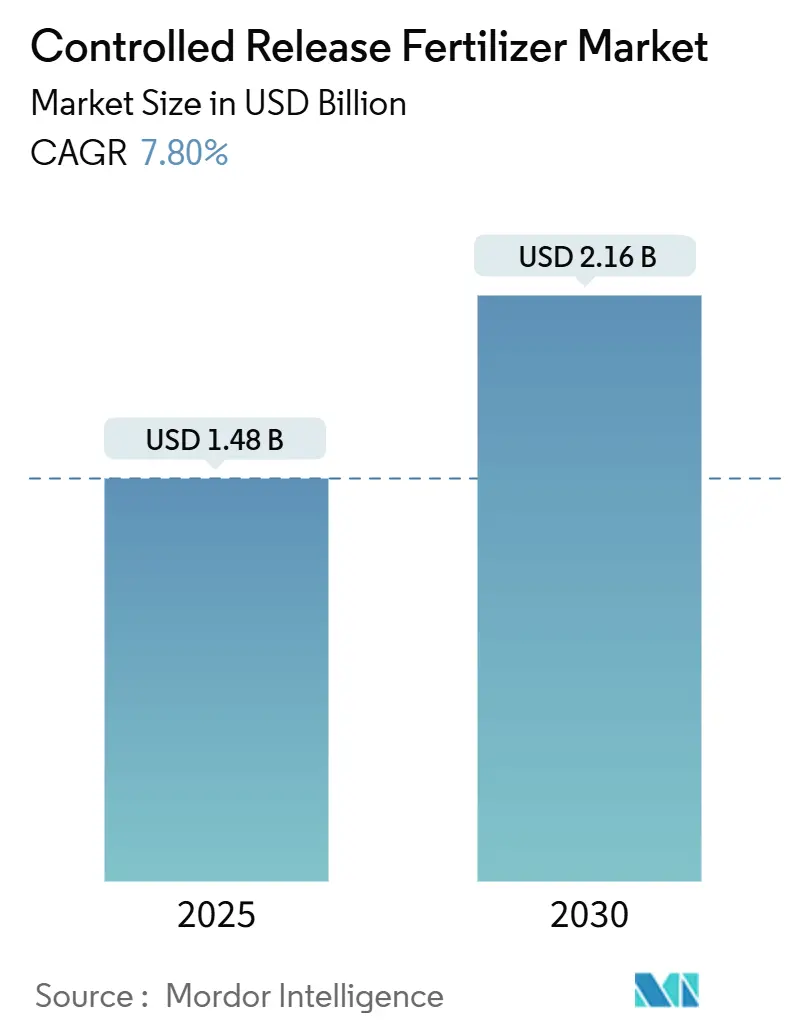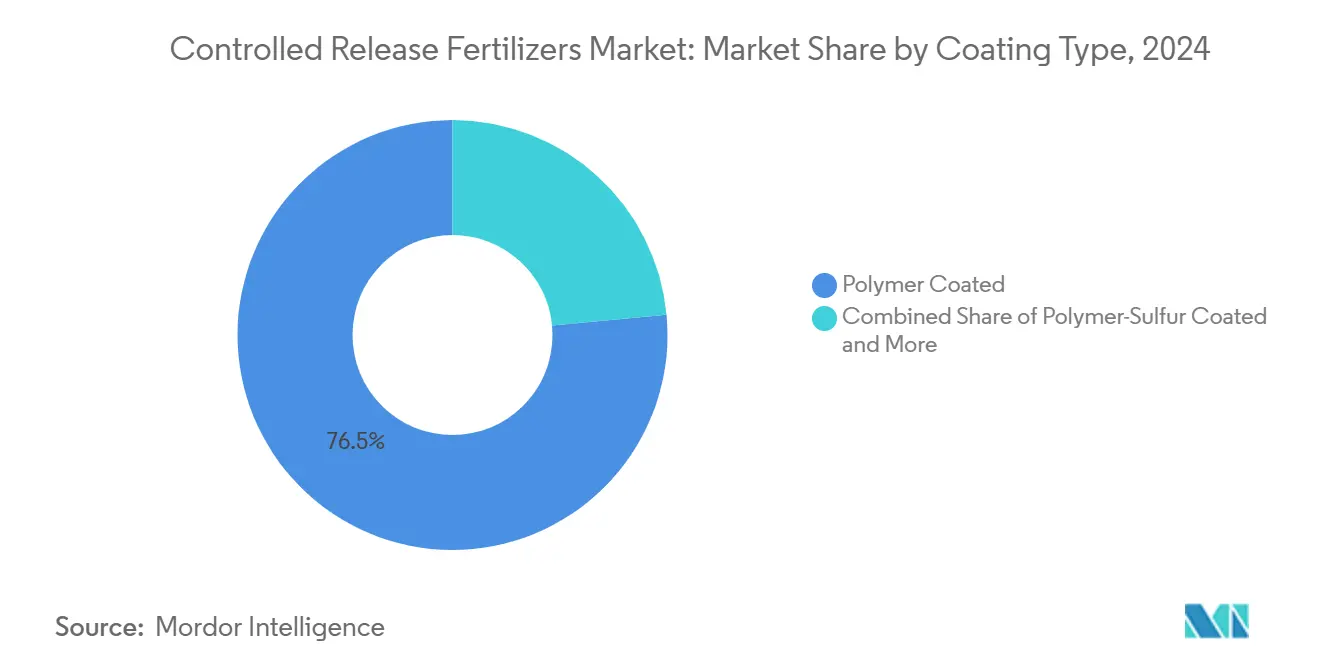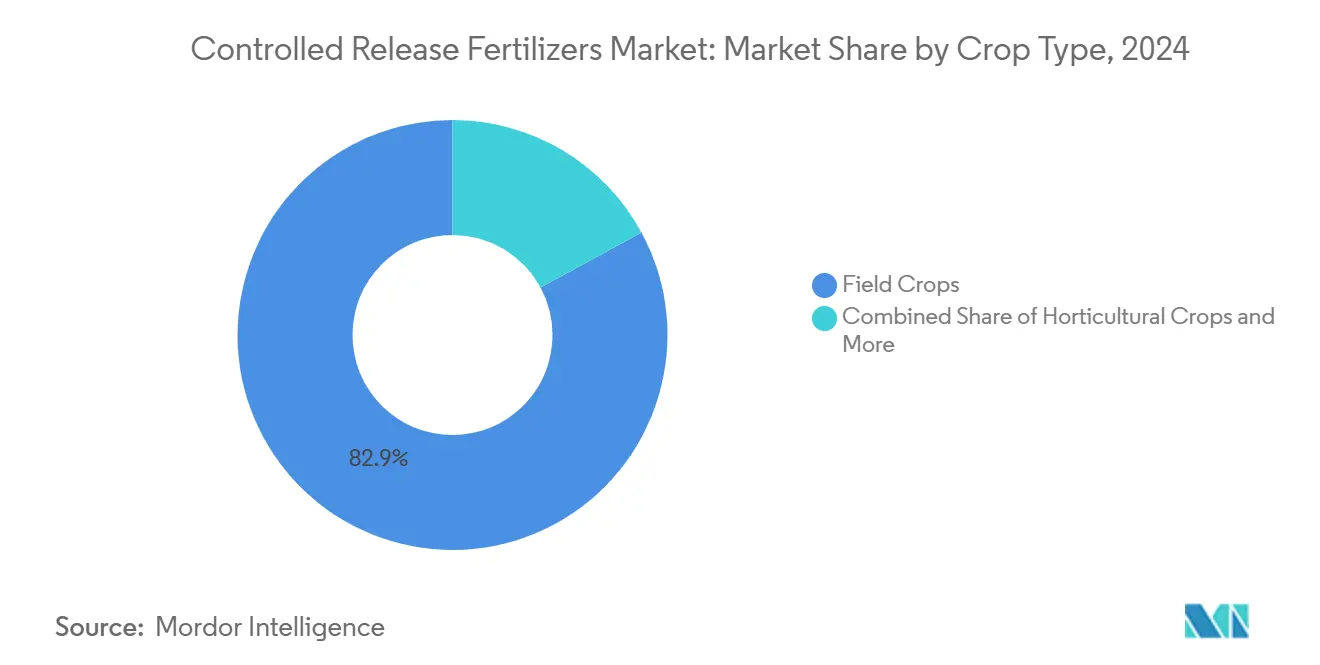
Controlled Release Fertilizers Market Analysis by Mordor Intelligence
The controlled release fertilizers market size reached USD 1.48 billion in 2025 and is projected to rise to USD 2.16 billion by 2030, reflecting a 7.80% CAGR during the forecast period. Adoption rides on precision nutrient management strategies that improve yield, curb nutrient loss, and align with tightening environmental regulations. Polymer-based coatings shape the technology landscape, while digital farming platforms create new value by linking real-time soil data with customized nutrient release schedules. Regional water scarcity pushes growers toward nutrient-efficient products, and government incentives accelerate uptake among large field-crop operations. Competitive intensity remains moderate, leaving room for innovators developing biodegradable coatings and data-driven decision tools.
Key Report Takeaways
- By Coating Type, polymer-coated products held 76.5% of the controlled release fertilizers market share in 2024 and are projected to advance at a 7.93% CAGR through 2030.
- By Crop Type, field crops accounted for 82.9% of the controlled release fertilizers market size in 2024, and horticultural crops are forecasted to expand at an 8.58% CAGR through 2030.
- By Region, North America accounted for 41.2% of the controlled release fertilizers market size in 2024, and Middle East & Africa are forecasted to expand at an 8.06% CAGR through 2030.
Global Controlled Release Fertilizers Market Trends and Insights
Drivers Impact Analysis
| Driver | (~) % Impact on CAGR Forecast | Geographic Relevance | Impact Timeline |
|---|---|---|---|
| Precision agriculture technology integration | +1.8% | Global; North America and Europe lead | Medium term (2-4 years) |
| Environmental regulations and sustainability mandates | +1.5% | Europe and North America core; Asia-Pacific expanding | Long term (≥ 4 years) |
| Water scarcity and irrigation efficiency | +1.3% | Middle East, Africa, and drought-prone zones worldwide | Long term (≥ 4 years) |
| Labor cost reduction and application convenience | +1.1% | Developed markets; adoption spreading in emerging regions | Medium term (2-4 years) |
| Climate change adaptation and crop resilience | +0.9% | Global; climate-vulnerable regions most affected | Long term (≥ 4 years) |
| Food security and productivity optimization | +0.7% | Population-dense regions worldwide | Long term (≥ 4 years) |
| Source: Mordor Intelligence | |||
Precision Agriculture Technology Integration
Variable-rate applicators now synchronize controlled release fertilizers with real-time soil nutrient maps, allowing growers to match coating thickness and release curves to micro-field conditions. Such orchestration reduces over- or under-fertilization events, boosts nutrient use efficiency, and extends product life cycles. Equipment makers bundle agronomic advisory and geospatial analytics, positioning controlled release fertilizers market participants in a broader digital ecosystem. Larger farms capture labor savings and environmental compliance credits, creating a reinforcing adoption loop that steadily expands the customer base.
Environmental Regulations and Sustainability Mandates Reshape Standards
Europe’s Farm to Fork Strategy classifies controlled release products as preferred inputs for achieving nitrogen use-efficiency benchmarks above 80%. The 2024 biodegradability clause spurred a USD 200 million niche for coatings that safely decompose within 12–18 months, a trend now influencing labels in North America and emerging Asia. Compliance incentives, such as reduced buffer-zone requirements, lower the total cost of ownership relative to conventional fertilizers. Consequently, the controlled release fertilizers market is increasingly entwined with policy frameworks that reward measurable sustainability outcomes. [1]Source: European Commission, “Farm to Fork Strategy,” europa.eu
Water Scarcity and Irrigation Efficiency Requirements Accelerate Adoption
NASA’s Global Water Resources Assessment underscores that farms deploying controlled release systems can cut irrigation events by 15–25% without yield loss. Continuous nutrient availability during dry spells minimizes plant stress and stabilizes returns in water-priced regions. Governments in the Middle East and North Africa include controlled-release products in subsidized drought-resilience programs, thus expanding market penetration among water-constrained growers.[2]Source: “Global Water Resources Assessment,” NASA, nasa.gov
Labor Cost Reduction and Application Convenience Transform Farm Operations
The 2024 USDA Farm Labor Survey shows 78% of U.S. farms struggled to secure applicators, reinforcing demand for once-per-season nutrition solutions. Controlled release fertilizers compress application rounds from three or four to one or two, freeing labor for other field tasks. Specialty crops benefit most because timing errors carry high quality penalties. As automation scales, labor savings amplify the total economic value, helping the controlled release fertilizers market capture budget share from conventional formulations.
Restraints Impact Analysis
| Restraint | (~) % Impact on CAGR Forecast | Geographic Relevance | Impact Timeline |
|---|---|---|---|
| High production costs and price premium | −1.2% | Global; strongest in price-sensitive emerging markets | Short term (≤ 2 years) |
| Limited farmer awareness and technical gaps | −0.8% | Emerging markets; pockets in developed regions | Medium term (2-4 years) |
| Microparticle-shedding concerns triggering lobbying for coating traceability | -0.4% | Emerging markets; pockets in developed regions | Medium term (2-4 |
| Inflation-driven polymer cost spikes squeezing CRF producer margins | -0.9% | Global supply chains affecting all Global markets | Short term (≤ 2 years) |
| Source: Mordor Intelligence | |||
High Production Costs and Price Premium Barriers Constrain Penetration
Polymer-coated fertilizers typically sell at two to three times the price of conventional products, and coating resins track volatile petroleum input costs that swung 15–25% in 2024. Smallholders operating on tight margins hesitate to adopt even when lifetime savings appear favorable. Producers respond with localized blending plants to cut logistics costs and with pay-per-acre service models to alleviate upfront expenditure. These moves could soften the restraint once economies of scale mature.
Limited Farmer Awareness and Technical Knowledge Gaps Impede Adoption
IFA’s 2024 survey shows that only 23% of growers in emerging markets receive guidance on selecting coating types, setting spreader calibrations, or calculating return on investment. Without competent advice, adopters risk mismatching crop requirements and losing the intended efficiency benefits. Manufacturers are funding extension programs and digital advisories to bridge the gap, but coverage remains uneven, slowing controlled release fertilizer market diffusion in several growth territories.
Segment Analysis
By Coating Type: Polymer-Coated Dominance Amid Eco-Innovation
Polymer-coated products held 76.5% of the controlled release fertilizer market share in 2024 and contributed the bulk of the controlled release fertilizer market size growth, progressing at a 7.93% CAGR through 2030. Their popularity stems from precise nutrient-release kinetics that integrate seamlessly with variable-rate applicators. Continuous research is lowering coating thickness without compromising durability, improving cost ratios, and field performance. Biodegradable variants that decompose within 18 months now meet European Union standards, bringing new customer segments that formerly resisted polymer accumulation concerns.
Polymer-sulfur hybrids play a niche role where extended sulfur nutrition is critical, particularly in oilseed belts facing soil sulfur depletion. The combination lowers input counts by co-delivering macro- and secondary nutrients over synchronized timelines. Wax and resin coatings remain in value-oriented channels where tight budgets override the need for high-precision release. These categories together provide portfolio breadth that helps suppliers address diverse regional agronomic realities.

Note: Segment shares of all individual segments available upon report purchase
By Crop Type: Horticulture Accelerates, Field Crops Anchor Volume
Field crops dominated volume, capturing 82.9% of the controlled release fertilizer market size in 2024, as large corn, wheat, and rice acres justify the technology’s labor and fuel savings. Large growers also benefit from bulk procurement discounts, reducing the effective premium per nutrient unit. In contrast, horticultural crops are set for 8.58% CAGR through 2030, the fastest among all crop segments, propelled by greenhouse expansion and specialty produce, which queries higher margins per acre.
Greenhouse operators appreciate the products’ stable nutrient release under controlled environment conditions, which simplifies fertigation scheduling and reduces salinity buildup. Turf and ornamental markets maintain steady uptake because municipalities and golf courses face runoff legislation that favors slow-release formats. Across segments, the increasing integration of controlled release fertilizers with fertigation and hydroponic systems is broadening use cases beyond traditional soil broadcasting.

Note: Segment shares of all individual segments available upon report purchase
Geography Analysis
North America accounted for a 41.2% share of the controlled release fertilizers market in 2024, supported by advanced precision agriculture infrastructure and regulatory cost-share programs that subsidize nutrient-efficient inputs. In the United States, growers benefit from Environmental Protection Agency (EPA) watershed guidelines, which classify controlled release products as best-management practices eligible for compliance credits. In Canada, the Sustainable Agriculture Initiative allocated CAD 150 million (USD 111 million) to facilitate the conversion of conventional acres, accelerating adoption in prairie grain belts and horticultural clusters.
The Middle East and Africa markets are projected to grow at a fastest CAGR of 8.06% through 2030, driven by water scarcity, which increases interest in low-leach products. However, price sensitivity and limited advisory networks pose challenges to immediate volume growth. Latin America’s large sugarcane and citrus holdings present emerging opportunities as regional distributors expand their portfolios by adding controlled release fertilizers lines.[3]Source: Agriculture and Agri-Food Canada, “Sustainable Agriculture Initiative,” agriculture.canada.ca
The Asia-Pacific region is experiencing significant growth, driven by China’s USD 2.3 billion precision agriculture stimulus and India’s focus on nutrient-use efficiency to enhance national food security. Government initiatives in the region include bundling equipment loans, agronomist support, and discounts on controlled release fertilizers, which create demonstration plots to accelerate adoption. Europe’s controlled release fertilizers market emphasizes compliance with the European Green Deal rather than volumetric expansion. Eco-scheme payments under the Common Agricultural Policy now reimburse up to 70% of incremental costs for proven nutrient-loss reductions, effectively offsetting the price premium for many arable farms.

Competitive Landscape
The controlled release fertilizer market exhibits high concentration, creating a competitive environment that balances established player advantages with opportunities for technology-focused entrants. ICL Group Ltd leverages vertical integration spanning from raw material production to specialized coating technologies, while Nutrien Ltd's share reflects its extensive distribution network and farmer relationship advantages. Strategic focus increasingly centers on developing next-generation coating materials that address environmental concerns while maintaining release precision, with patent filings for biodegradable polymer systems increasing 45% in 2024, according to the United States Patent and Trademark Office (USPTO) records.
White-space opportunities exist in developing markets where limited technical support infrastructure constrains adoption despite favorable economics for controlled release technologies. Emerging disruptors focus on bio-based coating materials and smart release systems that incorporate sensor technologies for real-time nutrient monitoring, though commercialization remains in early stages.
Technology integration strategies increasingly emphasize compatibility with precision agriculture platforms, creating competitive advantages for companies that successfully bridge fertilizer chemistry with digital farming systems. EPA registration requirements for new coating formulations create regulatory barriers that favor established players with existing approval pathways and technical expertise.
Controlled Release Fertilizers Industry Leaders
-
Grupa Azoty S.A. (Compo Expert)
-
ICL Group Ltd
-
Kingenta Ecological Engineering Group Co., Ltd.
-
New Mountain Capital (Florikan)
-
Nutrien Ltd.
- *Disclaimer: Major Players sorted in no particular order

Recent Industry Developments
- January 2024: Pursell Agritech and Yara have joined forces, with Yara incorporating Pursell's cutting-edge controlled-release fertilizer coating technology into its offerings. As a result of this partnership, Yara unveiled PurMidas, a novel controlled-release fertilizer (CRF) tailored for turf applications.
- March 2023: Syngenta and ICL have inked a fresh agreement, reinforcing their robust partnership that has significantly contributed to innovation, investment, and service in the turf industry. A highlight of this collaboration is the introduction of ICL’s eqo.s controlled release fertilizer technology.
Global Controlled Release Fertilizers Market Report Scope
| Polymer Coated |
| Polymer-Sulfur Coated |
| Others |
| Field Crops |
| Horticultural Crops |
| Turf & Ornamental |
| Asia-Pacific | Australia |
| Bangladesh | |
| China | |
| India | |
| Indonesia | |
| Japan | |
| Pakistan | |
| Philippines | |
| Thailand | |
| Vietnam | |
| Rest of Asia-Pacific | |
| Europe | France |
| Germany | |
| Italy | |
| Netherlands | |
| Russia | |
| Spain | |
| Ukraine | |
| United Kingdom | |
| Rest of Europe | |
| Middle East & Africa | Nigeria |
| Saudi Arabia | |
| South Africa | |
| Turkey | |
| Rest of Middle East & Africa | |
| North America | Canada |
| Mexico | |
| United States | |
| Rest of North America | |
| South America | Argentina |
| Brazil | |
| Rest of South America |
| Coating Type | Polymer Coated | |
| Polymer-Sulfur Coated | ||
| Others | ||
| Crop Type | Field Crops | |
| Horticultural Crops | ||
| Turf & Ornamental | ||
| Region | Asia-Pacific | Australia |
| Bangladesh | ||
| China | ||
| India | ||
| Indonesia | ||
| Japan | ||
| Pakistan | ||
| Philippines | ||
| Thailand | ||
| Vietnam | ||
| Rest of Asia-Pacific | ||
| Europe | France | |
| Germany | ||
| Italy | ||
| Netherlands | ||
| Russia | ||
| Spain | ||
| Ukraine | ||
| United Kingdom | ||
| Rest of Europe | ||
| Middle East & Africa | Nigeria | |
| Saudi Arabia | ||
| South Africa | ||
| Turkey | ||
| Rest of Middle East & Africa | ||
| North America | Canada | |
| Mexico | ||
| United States | ||
| Rest of North America | ||
| South America | Argentina | |
| Brazil | ||
| Rest of South America | ||
Market Definition
- MARKET ESTIMATION LEVEL - Market Estimations for various types of fertilizers has been done at the product-level and not at the nutrient-level.
- NUTRIENT TYPES COVERED - Urea & Complex
- AVERAGE NUTRIENT APPLICATION RATE - This refers to the average volume of nutrient consumed per hectare of farmland in each country.
- CROP TYPES COVERED - Field Crops: Cereals, Pulses, Oilseeds, and Fiber Crops Horticulture: Fruits, Vegetables, Plantation Crops and Spices, Turf Grass and Ornamentals
| Keyword | Definition |
|---|---|
| Fertilizer | Chemical substance applied to crops to ensure nutritional requirements, available in various forms such as granules, powders, liquid, water soluble, etc. |
| Specialty Fertilizer | Used for enhanced efficiency and nutrient availability applied through soil, foliar, and fertigation. Includes CRF, SRF, liquid fertilizer, and water soluble fertilizers. |
| Controlled-Release Fertilizers (CRF) | Coated with materials such as polymer, polymer-sulfur, and other materials such as resins to ensure nutrient availability to the crop for its entire life cycle. |
| Slow-Release Fertilizers (SRF) | Coated with materials such as sulfur, neem, etc., to ensure nutrient availability to the crop for a longer period. |
| Foliar Fertilizers | Consist of both liquid and water soluble fertilizers applied through foliar application. |
| Water-Soluble Fertilizers | Available in various forms including liquid, powder, etc., used in foliar and fertigation mode of fertilizer application. |
| Fertigation | Fertilizers applied through different irrigation systems such as drip irrigation, micro irrigation, sprinkler irrigation, etc. |
| Anhydrous Ammonia | Used as fertilizer, directly injected into the soil, available in gaseous liquid form. |
| Single Super Phosphate (SSP) | Phosphorus fertilizer containing only phosphorus which has lesser than or equal to 35%. |
| Triple Super Phosphate (TSP) | Phosphorus fertilizer containing only phosphorus greater than 35%. |
| Enhanced Efficiency Fertilizers | Fertilizers coated or treated with additional layers of various ingredients to make it more efficient compared to other fertilizers. |
| Conventional Fertilizer | Fertilizers applied to crops through traditional methods including broadcasting, row placement, ploughing soil placement, etc. |
| Chelated Micronutrients | Micronutrient fertilizers coated with chelating agents such as EDTA, EDDHA, DTPA, HEDTA, etc. |
| Liquid Fertilizers | Available in liquid form, majorly used for application of fertilizers to crops through foliar and fertigation. |
Research Methodology
Mordor Intelligence follows a four-step methodology in all our reports.
- Step-1: IDENTIFY KEY VARIABLES: In order to build a robust forecasting methodology, the variables and factors identified in Step-1 are tested against available historical market numbers. Through an iterative process, the variables required for market forecast are set and the model is built on the basis of these variables.
- Step-2: Build a Market Model: Market-size estimations for the forecast years are in nominal terms. Inflation is not a part of the pricing, and the average selling price (ASP) is kept constant throughout the forecast period for each country.
- Step-3: Validate and Finalize: In this important step, all market numbers, variables and analyst calls are validated through an extensive network of primary research experts from the market studied. The respondents are selected across levels and functions to generate a holistic picture of the market studied.
- Step-4: Research Outputs: Syndicated Reports, Custom Consulting Assignments, Databases & Subscription Platforms








